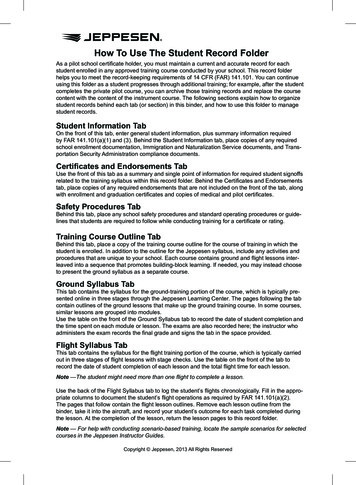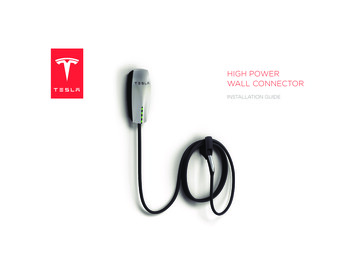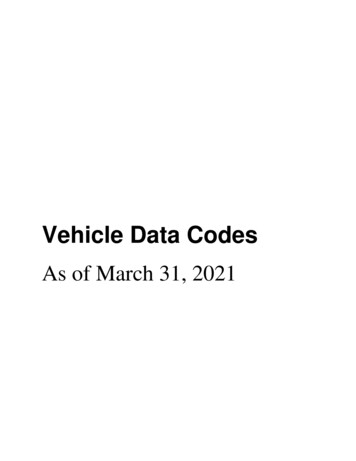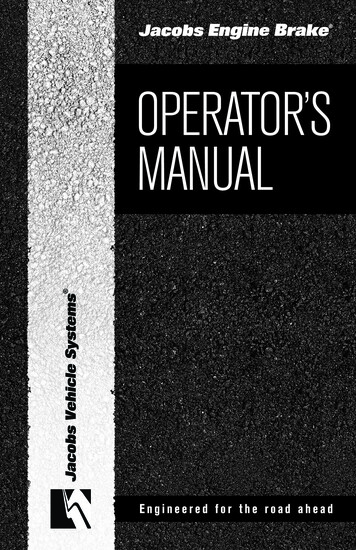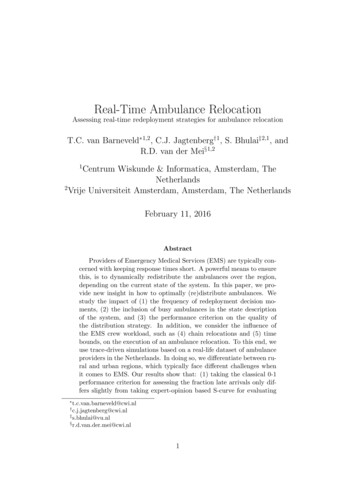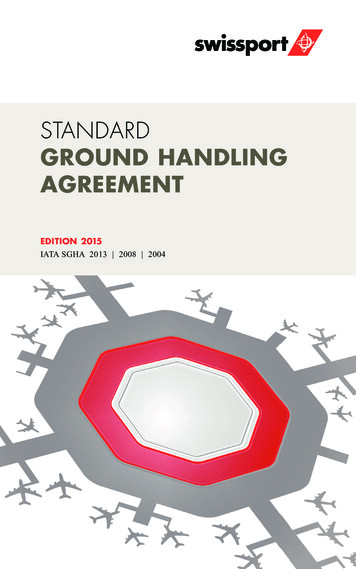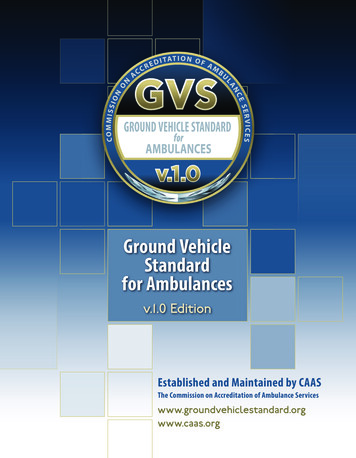
Transcription
Ground VehicleStandardfor Ambulancesv.1.0 EditionEstablished and Maintained by CAASThe Commission on Accreditation of Ambulance Serviceswww.groundvehiclestandard.orgwww.caas.org
CAAS GVS v.1.0AcknowledgementsThe following groups & individuals participated as the Steering Committee for the GVS v.1.0:PROJECT TEAMCommission on Accreditation of Ambulance Services (CAAS)Mark Meijer (Chair, CAAS)Mark Postma (Vice Chair, CAAS; GVS v.1.0 Project Co-Chair)Joe PennerDale Berry (Alternate)Sarah McEntee, EMT-P (Executive Director)Marcie McGlynn (Staff)Association and Society Management International (ASMI)Ian Weston, MPP, QAS, EMT (GVS v.1.0 Project Manager)ORGANIZATIONAL STAKEHOLDER LIASIONSAmbulance Manufacturers Division (AMD)Mark Van Arnam (GVS v.1.0 Project Co-Chair)Alain Brunelle (Alternate)National Association of EMTs (NAEMT)Skip Kirkwood, MS, JD, EMT-P, EFO, CEMSODon Lundy, BHS, NREMT-P (Alternate)American Ambulance Association (AAA)Ron Thackery, JDMike Hall (Alternate)National Association of State EMS Officials (NASEMSO)Michael Berg, BS, NRPDia Gainor (Alternate)American College of Emergency Physicians (ACEP)Sabina Braithwaite, MD, MPH, NREMT-PNational EMS Management Association (NEMSMA)Aarron Reinert, BA, NREMT-PTroy Hagen, MBA (Alternate)Association of Air Medical Services (AAMS)Rick SherlockElena Sierra (Alternate)National Association of EMS Physicians (NAEMSP)Brent Myers, MD, MPHLynn White, MS (Alternate)National Volunteer Fire Council (NVFC)Ken KnipperJoe Maruca (Alternate)Transportation Research Board (TRB)Bernardo KleinerGOVERNMENT AGENCY LIAISONS (NON-VOTING)U.S. Department of Homeland Security (DHS)Richard Patrick, MS, CFO, EMT-PPaul Brooks (Alternate)Eric Chaney (Alternate)James Grove (Alternate)National Highway Traffic Safety Administration (NHTSA)Drew DawsonDave Bryson (Alternate)National Institute of Standards and Technology (NIST)Jennifer MarshallAllison Barnard Feeney (Alternate)U.S. Department of Health & Human Services (HHS)Kevin Horahan, JD, MPH, EMT-PGregg Margolis, PhD, NREMT-P (Alternate)U.S. General Services Administration (GSA)John McDonaldNational Institute for Occupational Safety & Health (NIOSH)Jim vices
CAAS GVS v.1.0ABBREVIATIONS, TERMS & ACRONYMS USED IN THIS DOCUMENTAAAAmerican Ambulance AssociationGXLThin wall automotive wireAAMSAssociation of Air Medical ServicesHHSACAlternating currentU.S. Department of Health & HumanServicesACEPAmerican College of EmergencyPhysiciansIAFCInternational Association of Fire ChiefsILACInternational Laboratory AccreditationCooperationADAdditional dutyAMDAmbulance Manufacturers DivisionKKK-AAMECAAutomotive Manufacturers EquipmentCompliance AgencyFederal Specification for the Star-ofLife AmbulanceMILMilitaryANSIAmerican National Standards InstituteMRAMutual Recognition ArrangementASMIAssociation and Society ManagementInternationalNACLANational Cooperation for LaboratoryAccreditationASTMAmerican Society For Testing AndMaterialsNAEMSPNational Association of EMS PhysiciansNAEMTNational Association of EMTsAVSCAutomatic vehicle stability controlNASEMSOCAASCommission on the Accreditation ofAmbulance ServicesNational Association of State EMSOfficialsNECNational Electrical CodeCARBCenter for Advanced Research inBiotechnologyNEMANational Electrical ManufacturersAssociationCFRCode of Federal RegulationsNEMSMACGCenter of gravityNational EMS ManagementAssociationDCDirect currentNFPANational Fire Protection AssociationDHSU.S. Department of Homeland SecurityNHTSADOTU.S. Department of TransportationNational Highway Traffic SafetyAdministrationEMSCEmergency Medical Services ForChildren ProgramNIOSHNational Institute for OccupationalSafety & HealthEMSPEmergency medical service providerNISTEPAU.S. Environmental Protection AgencyNational Institute of Standards andTechnologyEPDMEthylene propylene terpolymer rubberNTEANational Truck Equipment AssociationFCCFederal Communications CommissionNVFCNational Volunteer Fire CouncilFMCSRFederal Motor Carrier SafetyRegulationsOEMOriginal Equipment ManufacturerOSHAFMVSSFederal Motor Vehicle SafetyStandardsOccupational Safety and HealthAdministrationRFRadio frequencyFSAMFinal stage ambulance manufacturerRPMRevolutions per minuteGAWRGross axle weight ratingSAESociety Of Automotive EngineersGSAU.S. General Services AdministrationSXLStandard wall automotive wireGVSGround Vehicle StandardTRBTransportation Research BoardGVWRGross vehicle weight ratingUSPUnited States tionofAmbulanceServices
CAAS GVS v.1.0TABLE OF CONTENTSSECTION A - SCOPE, PURPOSE, CLASSIFICATION AND DEFINITIONS4SECTION B - APPLICABLE DOCUMENTS6SECTION C - 2C.13C.14C.15C.16C.17C.18C.19GENERAL VEHICULAR DESIGN, TYPES, AND CONFIGURATIONVEHICLE, AMBULANCE COMPONENTS, EQUIPMENT, AND ACCESSORIESRECOVERED MATERIALSVEHICLE OPERATION, PERFORMANCE, AND PHYSICAL CHARACTERISTICSVEHICLE WEIGHT RATINGS AND PAYLOADCHASSIS, POWER UNIT, AND COMPONENTSELECTRICAL SYSTEM AND COMPONENTSLIGHTING, EXTERIOR AND INTERIORCAB-BODY DRIVER COMPARTMENT AND EQUIPMENTAMBULANCE BODY AND PATIENT AREASTORAGE COMPARTMENTSOXYGEN, MAIN SUPPLY AND INSTALLATION AND SUCTIONENVIRONMENTAL: CLIMATIC AND NOISE PARAMETERSCOMMUNICATIONSADDITIONAL SYSTEMS, EQUIPMENT, ACCESSORIES, AND SUPPLIESPAINTING, COLOR, AND MARKINGSMARKINGS, AND CAUTION AND IDENTIFICATION PLATESMANUALS AND HANDBOOK OF INSTRUCTIONWORKMANSHIP N D - CAAS GVS COMPLIANCE CERTIFICATION REQUIREMENTSD.1D.2D.3D.4D.5D.6QUALIFYING PROVISIONSDOCUMENTATION OF “CAAS GVS v.1.0” COMPLIANCE CERTIFICATIONCRITERIA OF CERTIFICATIONSCERTIFICATION LETTER FORMATCERTIFICATION VERIFICATION DATA REPORTSTESTS39393939404040SECTION E - CHANGES AND AMENDMENTSE.1E.2E.3CHANGES AND AMENDMENTSGENERAL INQUIRIES – REQUEST FOR INTERPRETATIONPROCESS FOR REVISION41414141APPENDIX 1 - FIGURES42APPENDIX 2 - BUYERS ervices
CAAS GVS v.1.0SECTION A - SCOPE, PURPOSE, CLASSIFICATION AND DEFINITIONSA.1SCOPEThis Standard identifies the minimum requirements for new automotive Emergency Medical Services(EMS) ground ambulances built on Original Equipment Manufacturer's Chassis (OEM) that are preparedby the OEM for use as an ambulance. This Standard applies to new vehicles only.The Standards referenced in GVS v.1.0 do not apply to the following vehicle categories:1. Military Vehicles/Combat Support Ambulances2. Stretcher Vans/Wheel Chair Vans/Transport Vehicles3. Mass-Casualty Vehicles/Ambulance Buses4. Refurbished or Remounted Ambulance5. Fire Suppression ApparatusAPPENDIX 2 of this standard contains:1. Optional configurations.2. A worksheet to assist the purchaser in developing their procurement requirements.A.2PURPOSEThe object of CAAS, this document, and ambulance standard is to best serve patients by providingground ambulances that are safe, nationally recognized, properly constructed, easily maintained, and,when professionally staffed and provisioned, will function reliably in pre-hospital or other mobileemergency medical service. The purpose of this document is to identify the standards for groundambulances that are authorized to display the “CAAS GVS” symbol. It establishes minimumrequirements, performance parameters and essential criteria for the design of ground ambulances inan effort to provide a practical degree of standardization and for the safety, comfort, and avoidance ofaggravation of the patient’s injury or illness.A.3“CAAS GVS” CERTIFICATIONThe final stage ambulance manufacturer (FSAM) shall furnish to a purchaser an authenticatedcertification and label stating that the ambulance and equipment comply with the current standard ineffect on the date the ambulance is contracted for. FSAMs making this certification are permitted touse the “CAAS GVS” symbol to identify an ambulance as compliant with the CAAS standards forambulances. Use of the symbol must be in accordance with the purpose and use criteria set forth inthese published guidelines by the Commission on Accreditation of Ambulance Services.A.4DEFINITIONSA.4.1DEFINITION OF GROUND AMBULANCEThe ambulance is defined as a vehicle used for emergency medical care that consists of:1. A driver’s cab compartment.2. A patient compartment to accommodate an emergency medical services provider (EMSP) and aminimum of one patient located on the primary cot so positioned that the patient(s) can receiveappropriate medical care during transit.3. Accommodation for storage of equipment and supplies for emergency care at the scene as well asduring transport.4. Accommodation for installation of communication systems.4
CAAS GVS v.1.05. Audible and Visual Traffic warning devices.A.4.2DEFINITION OF ADDITIONAL CONSIDERATIONSAdditional Considerations located throughout this document. These boxes contain recommendationsthat currently exceed or enhance the existing standard to address specific needs or future innovationsat the individual purchaser preference. Some local and state requirements may supersede theserequirements.A.4.3RECOVERED MATERIALSThe term “recovered materials” means materials that have been collected or recovered from solidwaste and reprocessed to become a source of raw materials, as opposed to virgin raw materials.5
CAAS GVS v.1.0SECTION B - APPLICABLE DOCUMENTSB.1THE FOLLOWING STANDARDS AND REGULATIONS FORM A PART OF THIS STANDARD, TO THE EXTENTSPECIFIED OR REQUIRED BY LAW. UNLESS A SPECIFIC ISSUE OF A STANDARD OR REGULATION ISIDENTIFIED, THE ISSUE IN EFFECT, ON THE DATE THE AMBULANCE IS CONTRACTED FOR, SHALLAPPLY.Military Standards:MIL-STD-461Requirements for the Control of Electromagnetic Interference Characteristicsof Subsystems and Equipment.LAWS AND REGULATIONS:29 CFR 1910.7Definition and Requirements for a Nationally Recognized Testing Laboratory40 CFR 86Control of Air Pollution from New Motor Vehicles and New Motor VehicleEngines47 CFR, PART 90Public Safety Radio Services (FCC)49 CFR 571Federal Motor Vehicle Safety Standards (FMVSS)29 CFR 1910.95Occupational Noise ExposureISO STANDARDS:ISO/IEC 17025General requirements for the competence of testing and calibrationlaboratoriesNational Truck Equipment Association / Ambulance Manufacturers Division (AMD):AMD Standard 001Ambulance Body Structure Static Load TestAMD Standard 004Litter Retention SystemAMD Standard 00512-volt DC Electrical System TestAMD Standard 006Patient Compartment Sound Level TestAMD Standard 007Patient Compartment Carbon Monoxide Level TestAMD Standard 008Patient Compartment Grab Rail Static Load TestAMD Standard 009125v AC Electrical Systems TestAMD Standard 010Water Spray TestAMD Standard 011Equipment Temperature TestAMD Standard 012Interior Climate Control TestAMD Standard 013Weight Distribution GuidelinesAMD Standard 014Engine Cooling System TestAMD Standard 015Ambulance Main Oxygen System TestAMD Standard 016Patient Compartment Lighting Level TestAMD Standard 017Road TestAMD Standard 018Rear Step and Bumper Static Load TestAMD Standard 019Measuring Guidelines: Cabinets & CompartmentsAMD Standard 020Floor Distributed Load TestAMD Standard 021Aspirator System Test, Primary PatientAMD Standard 022Cold Engine Start TestAMD Standard 023Siren Performance TestAMD Standard 024Perimeter Illumination TestAMD Standard 025Measuring Guidelines: Occupant Head Clearance Zones6
CAAS GVS v.1.0Society Of Automotive Engineers (SAE) International, Standards, And Recommended Practices:J163 Low Tension Wiring and Cable Terminals and Splice ClipsJ551 Performance Levels and Methods of Measurement of Electromagnetic Compatibility ofVehicles, Boats, and MachinesJ553 Circuit BreakersJ561 Electrical Terminals, Eyelet, and Spade TypeJ575 Tests for Motor Vehicle Lighting Devices & ComponentsJ576 Plastic Materials, For Use In Optical Parts Such As Lenses and Reflectors of Motor VehicleLighting DevicesJ578 Color Specification for Electric Signal Lighting DevicesJ683 Tire Chain ClearanceJ845 Optical Warning Devices for Authorized Emergency, Maintenance, and Services VehiclesJ928 Electrical Terminals, Pin, and Receptacle TypeJ1100 Motor Vehicle DimensionsJ1128 Low Voltage Primary CableJ2498 Minimum Performance of the Warning Light System Used on Emergency VehiclesJ3026 Ambulance Patient Compartment Seating Integrity and Occupant RestraintJ3027 Ambulance Litter Integrity, Retention, and Patient RestraintJ3043 Ambulance Equipment Mount Device or SystemsNational Fire Protection Association (NFPA)1901 Standard for Automotive Fire Apparatus70National Electric CodeAmerican Society For Testing And Materials (ASTM) Standards:B117 Standard Practice for Operating Salt Spray (Fog) Apparatus IPC-610D Acceptability of ElectronicAssembliesB.2OTHER PUBLICATIONSThe following documents are useful references. Unless a specific issue is identified, the issue in effect,on the date the ambulance is contracted for, shall apply.Federal Standards:RR-C-901CCylinders, Compressed Gas: High Pressure, Steel DOT 3aa And AluminumApplicationsStandard No. 297Rustproofing of Commercial (Non-tactical) VehiclesMIL-STD-1223Non-tactical Wheeled Vehicles, Painting, Identification Marking, and Data PlateStandards.29 CFR 1910.103021 CFR 820Bloodborne PathogensQuality System RegulationSociety Of Automotive Engineers, International, Standards, And Recommended Practices:J537 Storage BatteriesJ541 Voltage Drop for Starting Motor Circuits7
CAAS GVS 1318Flashing Warning Lamps for Authorized Emergency, Maintenance, and Service VehiclesTest Procedure and Ratings for Hot Water Heaters for Motor VehiclesSafety Practices for Mechanical Vapor Compression Refrigeration Equipment or Systems UsedTo Cool Passenger Compartment of Motor VehiclesRear Wheel Splash and Stone Throw ProtectionElectrical Terminals, Blade TypeBackup Alarms, Performance Test and ApplicationWarning Lamp, Alternating FlashersBattery CableAutomobile, Truck, Truck-Tractor, Trailer, and Motor Coach WiringEngine Power Test Code, Spark Ignition and DieselStrobe Warning LightsAmerican College Of Emergency Physicians (ACEP):Guidelines for Ambulance EquipmentAmerican National Standards Institute (ANSI):Z535.1American National Standard for Safety ColorsAmerican Society For Testing And Materials Standards:F 920 Standard Specification for Minimum Performance and Safety Requirements for ResuscitatorsIntended for Use with HumansF 960 Standard Specification for Medical and Surgical Suction and Drainage SystemsD 4956 Standard Specification for Retroreflective Sheeting for Traffic ControlD6210 Standard Specification for Fully-Formulated Glycol Base Engine Coolant for Heavy-Duty EnginesAutomotive Manufacturers Equipment Compliance Agency (AMECA):Approval of Motor Vehicle Safety Equipment (emergency lights and sirens)National Emergency Medical Services For Children (EMSC) National Resource Center (NRC):Committee On Ambulance Equipment And SuppliesGuidelines for Pediatric Equipment and Supplies for Basic and Advanced Life Support AmbulancesTire and Rim Association2015-Year BookB.3ORDER OF PRECEDENCEIn the event of a conflict between the text of this standard and the references cited, the text of thisstandard shall take precedence.8
CAAS GVS v.1.0SECTION C - REQUIREMENTSC.1GENERAL VEHICULAR DESIGN, TYPES, AND CONFIGURATIONC.1.1DESIGNThe ambulance and equipment furnished under this standard shall be the OEM’s untitled commercialvehicle of the Type and Configuration specified. The ambulance shall be complete with the operatingaccessories, as specified by the purchaser. The design of the vehicle and the specified equipment shallpermit accessibility for servicing, replacement, and adjustment of component parts and accessorieswith minimum disturbance to other components and systems. The term “heavy- duty,” as used todescribe an item, shall mean in excess of the standard quantity, quality, or capacity and represents thebest, most durable, strongest, etc., part, component, system, etc., that is commercially available on theOEM chassis.C.1.2TYPE I AMBULANCE (10,001 TO 14,000 Gross Vehicle Weight Rating (GVWR))Type I vehicle shall be a cab chassis furnished with a modular ambulance body.C.1.2.1 TYPE I-AD (ADDITIONAL DUTY) AMBULANCE (14,001 GVWR OR MORE)Type I-AD shall be a Cab-Chassis with modular ambulance body, increased GVWR, storage, andpayload.C.1.3TYPE II AMBULANCE (8,501 – 10,000 GVWR)Type II ambulance shall be a chassis, with Integrated cab-body.C.1.4TYPE III AMBULANCE (10,001 TO 14,000 GVWR)Type III shall be a Cutaway Van with modular ambulance body.C.1.4.1 TYPE III-AD AMBULANCE (14,001 GVWR OR MORE)Type III-AD shall be a Cutaway Van with modular body, and increased GVWR, storage, and payload.C.1.5CONFIGURATION OF PATIENT COMPARTMENTThe primary cot shall be mounted to provide maximum access from the EMSP seat.C.2VEHICLE, AMBULANCE COMPONENTS, EQUIPMENT, AND ACCESSORIESThe ambulance’s chassis, cab, patient compartment, and accessories supplied by the FSAM, shall bestandard commercial products, tested and certified to meet or exceed the requirements of thisStandard. The ambulance shall comply with all Federal Motor Vehicle Safety Standards and otherapplicable Federal and state regulations specified for the year of manufacture. The chassis,components, and optional items shall be as represented in the OEM’s current technical data. Theambulance body, equipment, and accessories shall be as represented in their respective FSAM’scurrent technical data.C.3RECOVERED MATERIALSAll equipment, material, and articles required under this standard are to be new or fabricated fromnew materials not produced from recovered materials. None of these materials shall be interpreted tomean that the use of used or rebuilt products is allowed.9
CAAS GVS v.1.0C.4VEHICLE OPERATION, PERFORMANCE, AND PHYSICAL CHARACTERISTICSAll requirements in Section C.4 shall be met with the ambulance loaded at curb weight plus totalusable payload.C.4.1TEMPERATURE CONDITIONSThe vehicle shall be capable of operating safely and efficiently, according to AMD Standard 011(Equipment Temperature Test) and under the following environmental conditions:C.4.1.1 ENVIRONMENTAL CONDITIONSThe ambulance shall be tested to operate at a minimum ambient temperature range from 0 F to 95 F.C.4.2NOISE AND SOUND LEVEL LIMITS, EXTERIORUnless more stringent sound levels are regulated by the states and municipalities where theambulance will be based, the exterior noise level produced by the vehicle, except siren, shall notexceed Federal regulations.C.4.3VEHICLE PERFORMANCEThe ambulance shall provide a smooth, stable ride. When available from the OEM, automatic vehiclestability control (AVSC) shall be furnished. The completed ambulance shall conform to AMD Standard017 (Road Test).C.4.4SPEEDThe vehicles shall be capable of a sustained speed of not less than 65 mph over dry, hard surfaced,level roads, at sea level, and passing speeds of not less than 70 mph when tested in accordance withAMD Standard 017.C.4.5ACCELERATIONVehicle shall have a minimum average acceleration, at sea level, of 0-55 mph within 25 seconds. Testshall be performed in accordance with AMD Standard 017 (Road Test).C.4.6GRADEABILITYThe vehicle shall be capable of meeting the following performance requirements. The determinationshall be made by actual test or OEM’s certified computer prediction.C.4.6.1 GRADEABILITY AT SPEEDMinimum gradeability at speed shall be 55 mph on a 3% (1.72 ) grade.C.4.6.2 MINIMUM LOW SPEED GRADEABILITYThe minimum low speed gradeability shall be 5 mph on a 35% (19.3 ) grade.C.4.7FORDINGThe vehicle shall be capable of three fordings, without water entering patient and equipmentcompartments while being driven through a minimum of 8" of water, at speeds of 5 mph, for adistance of at least 100', in accordance with AMD Standard 017 (Road Test).C.4.8VEHICLE PHYSICAL DIMENSIONAL REQUIREMENTSThe ambulance dimensions (length, width, height) must comply with all applicable local, state and10
CAAS GVS v.1.0Federal regulations. Length, width, and height are defined by, and should be documented in thepurchasing agreement:LENGTHOverall length of the ambulance (OAL) specified shall include bumpers, rear step and bumper guards.WIDTHThe overall width of ambulance bodies shall exclude mirrors, lights, and other safety appurtenances.HEIGHTOverall height shall be when loaded to curb weight. This should include roof-mounted equipment, butexcludes two-way radio antenna(s).C.4.8.1 ANGLE OF APPROACH, RAMP BREAKOVER AND DEPARTUREWith the exception of the OEM’s furnished and installed components, the ambulance shall provide notless than the following clearance (in according with test procedure SAE J1100 (Motor VehicleDimensions” )):Approach angle 20 Ramp breakover 10 Departure angle 10 C.4.8.2 TURNING RADIUSTurning radius shall not be greater than the OEM standard.C.4.8.3 FLOOR HEIGHTThe floor load height shall be a maximum of 34” in order to facilitate manual and/or power cot loading.C.5VEHICLE WEIGHT RATINGS AND PAYLOADC.5.1CURB WEIGHTNon-permanently mounted equipment is considered to be part of the payload, not the curb weight.C.5.2PAYLOAD CAPACITYThe required minimum payload (patients, passengers and cargo/equipment) per vehicle with optionalpermanently mounted equipment shall be 1,300 lbs.Each ambulance’s payload capacity shall be determined by completing a National Truck EquipmentAssociation (NTEA) UltraMod spreadsheet (available at www.ntea.com). A copy of the spreadsheetshall be included in the handbook of instructions. The following shall be shown on the spreadsheet:1. Completed vehicle at curb weight2. 171 pounds at the horizontal center of each patient location and at each seated position3. The maximum remaining Cargo/Equipment capacity located at the horizontal center of the patientcompartment that does not result in weights that exceed the vehicle’s GVWR, front or rear GAWRCertification and payload signage as shown in Figure 1 shall include the total usable cargo/equipment11
CAAS GVS v.1.0capacity value (Figure 2, item 10). The label shall be located in a conspicuous location in theambulance.C.5.3GROSS VEHICLE WEIGHT RATINGThe combination of the vehicle’s curb weight and total usable payload weight shall not exceed theambulance GVWR.C.5.4WEIGHT DISTRIBUTIONPurchasers and FSAMs shall locate vehicle-mounted components, equipment, and supplies to provide avehicle that is laterally balanced and within the GVWR and each gross axle weight rating. The right andleft wheel(s) of each axle of a completed ambulance shall be weighed to determine horizontal andlateral weight distribution. The weight distribution of a properly loaded ambulance on a level surfaceshall permit conformance to the FMVSS 105 braking requirements in accordance with the statementsprovided by the OEM. The ambulance shall conform to AMD Standard 013 (Weight DistributionGuidelines). All specifications and requirements for weight distribution and center of gravity of theOEM, where the OEM’s requirements are more restrictive or comprehensive, shall take precedenceover the requirements contained in this section.1. The weight between the right and left side of a given axle, when on a level surface, shall be within5%.2. When loaded to the GVWR and within the GAWR for each axle, the front to rear weightdistribution shall have not less than 20% of the total weight on the front axle, and not less than50% nor more than 80% on the rear axle.3. The FSAM shall locate the center of gravity (CG) of the vehicle according to the requirements set bythe OEM to determine and assure that the CG of the completed ambulance does not exceed anymaximum horizontal and/or vertical limits.To meet the above weight distribution requirements, consideration shall be given by the purchaser andFSAM to locate equipment and components to permit inherently proper lateral balance, front/rear axleloading, and center of gravity position.C.5.5RATINGSVehicle and component ratings shall be the OEM’s published ratings and shall not be raised above theOEM’s rating.C.6CHASSIS, POWER UNIT, AND COMPONENTSC.6.1CHASSIS-FRAMEThe chassis shall include the OEM’s ambulance preparation package when available. The chassis-frameand components shall be constructed to withstand the strains of on-off road service and any specialservice and equipment requirements specified. All chassis (including cab) components shall be asrepresented in the OEM’s technical data.C.6.2VEHICLE LUBRICATIONThe chassis components, devices, accessories, and added equipment requiring lubrication shall be fullyequipped with lubrication fittings, as provided by the OEM or equipment manufacturer.C.6.3POWER UNIT, ENGINE12
CAAS GVS v.1.0C.6.3.1 POWER UNITThe power unit shall meet or exceed the required vehicle performance specified at not more than theengine manufacturer’s recommended operating engine speed. The OEM’s diesel or gas engine andpower train shall be provided. Alternative Fuel systems (for systems such as LPG and CNG) arepermitted so long as they are approved by the OEM.C.6.3.2 ENGINE LOW TEMPERATURE STARTINGThe engine shall start satisfactorily without the aid of engine block preheating devices (except glowplugs) or combustion air preheater at 0 F. The determination shall be made by actual test conformingto AMD Standard 022 (Cold Engine Start Test) or OEM’s certification.C.6.4POWER UNIT COMPONENTSC.6.4.1 OIL FILTERThe oil filter shall be the OEM’s standard for the engine offered.C.6.4.2 AIR FILTERThe air filter shall be the OEM’s standard for the engine offered.C.6.4.3 AIR POLLUTION CONTROLThe vehicle and engine shall conform to 40 CFR Subchapter C-Part 86 - “Control of Emissions from Newand In-use Highway Vehicles and Engines", as evidenced by an EPA certificate of compliance. Vehiclesshall also comply with all pollution control requirements for the state of final destination. Certificatesof compliance shall be made available upon request.C.6.4.4 FUEL SYSTEMThe fuel system shall conform to all applicable FMVSS, Federal Motor Carrier SafetyRegulations (FMCSR), Center for Advanced Research in Biotechnology (CARB), and EnvironmentalProtection Agency (EPA) requirements. The fuel system components shall be installed, connected, androuted in accordance with all OEM’s guidelines. A permanent label at the fuel filler opening shall befurnished specifying the specific type of fuel required.C.6.4.5 COOLING SYSTEMA coolant overflow recovery tank and compensating system shall be furnished. The cooling systemshall be protected with an OEM solution of extended life antifreeze/coolant. Coolant to be the OEM’srecommended type and mixture. The FSAM shall provide the OEM maximum size cooling system forthe engine provided. The cooling system design shall maintain the engine at safe operatingtemperatures at all drivable altitudes and grades encountered during on and off road vehicle use. Theengine cooling system shall conform to AMD Standard 014 (Engine Cooling System Test).C.6.4.6 EXHAUST SYSTEMThe exhaust shall discharge at the vertical side(s) of the ambulance at a maximum distance of 1"beyond the side of the module and be angled /positioned to project the exhaust away from the door(s)to minimize fumes and contaminants entering the interior. On modular vehicles, the tailpipe outletshall not terminate within 12" of the vertical axis of the fuel tank filler opening(s) when located on thesame side. Modifications or extensions made to the OEM exhaust system shall meet or exceed OEM’srequirements in terms of backpressure, components, design, and workmanship.13
CAAS GVS v.1.0C.6.5DRIVE TRAINC.6.5.1 DRIVE TRAIN COMPONENTSThe drive train and component’s torque capacity shall meet or exceed the maximum torque developedin the lowest gear ratio by the engine.C.6.5.2 AUTOMATIC TRANSMISSIONThe OEM’s automatic transmission shall be provided. The transmission shall provide not less than fourspeeds forward and one reverse and shall be equipped with the OEM’s heaviest duty transmission fluidcooler.C.6.5.3 BRAKE SYSTEMS, SERVICE AND PARKINGOEM’s heaviest duty, power assisted brakes, linings, and parking brake shall be furnished on the OEMchassis offered. Antilock brake systems shall be furnished when available from the OEM.C.6.5.4 SPECIAL TRACTION (REAR END) DIFFERENTIALAll ambulances shall have a positive traction, limited slip differential or automatic, locking typedifferential, or electronic traction control.C.6.5.5 SUSPENSIONVehicle shall be equipped with laterally matched sets (front and rear) of suspension systemcomponents. Components shall have a rated capacity in excess of the load imposed on each member.Only corrections permitted by the OEM to compensate for lean due to normal spring tolerancevariations are permitted. Correction of lean due to imbalance is not permitted.C.6.5.6 SPRING STOPSThe OEM’s standard spring bumpers and axle stops shall be furnished. The stops/bumpers shall prevent the wheel and axles from striking the engine, oil pan, fenders, and body under all conditions ofoperation.C.6.6STEERINGThe OEM’s standard, power assisted steering shall be furnished.C.6.7WHEELSWheels shall conform to the recommendations of the Tire and Rim Association, Inc., and shall berecommended by the OEM guidelines.C.6.8TIRE CHAINS AND CLEARANCETire chain clearance on the furnished body shall be provided for all driving wheels per SAE J683.Sufficient chain clearance shall be provided to permit off road operation with the ambulance loaded tothe maximum payload.C.6.9WHEEL TIRE BALANCINGWheel/tire, hubs, and brake drum assemblies of the vehicle shall be dynamically balanced to aminimum of 70 mph.C.6.10 WINDSHIELD WIPERS AND WASHERSVehicle shall be equipped with intermittent windshield wipers.14
CAAS GVS v.1.0C.6.11 HORN(S)Electric horn(s) shall be furnished.C.7ELECTRICAL SYSTEM AND COMPONENTSC.7.1ELECTRICAL SYSTEMThe ambulance electrical system shall be equipped with, but not limited to
c.9 cab-body driver compartment and equipment 25 c.10 ambulance body and patient area 27 c.11 storage compartments 31 c.12 oxygen, main supply and installation and suction 33 c.13 environmental




